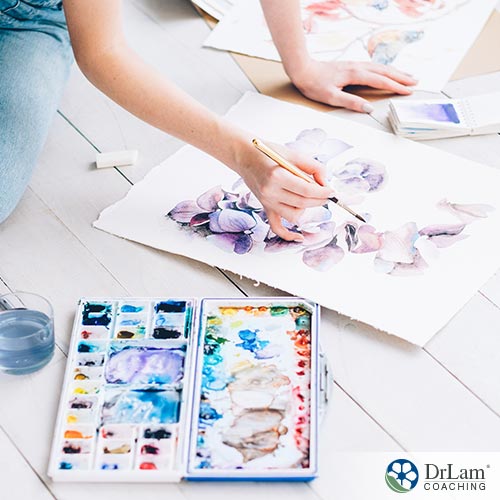 You may have heard of art therapy before. You might even have an idea of how relaxing and therapeutic it can be. Maybe you’ve even tried it and found it to really help you calm down and feel more grounded. But did you know that it has an actual physiological stress-relieving effect? That’s what we’ll talk about in this article, as well as some of its most useful mental health benefits.
You may have heard of art therapy before. You might even have an idea of how relaxing and therapeutic it can be. Maybe you’ve even tried it and found it to really help you calm down and feel more grounded. But did you know that it has an actual physiological stress-relieving effect? That’s what we’ll talk about in this article, as well as some of its most useful mental health benefits.
But first, a primer on stress and its biomarkers.
Stress is your body’s response to a stressor. And it’s not always a bad thing. The stress response, when working properly, is a natural and important part of physical and mental wellbeing. A stressor can be psychological or physical. Psychological stressors include things like work pressure, financial burdens, or relationship trouble. Physical stressors include things like an unhealthy diet, an injury, a sedentary lifestyle, or exposure to toxins.
Stressors can cause acute or chronic stress. Your body was built to handle acute stress. But chronic stress, on the other hand, can create many problems, and it’s what most types of therapy aim to reduce.
One of the most useful biomarkers of the stress response is cortisol, which is your body’s main anti-stress hormone. Cortisol helps your body adapt to the presence of a stressor by making your heart rate and breathing speed up so more oxygenated blood reaches your muscles and brain. It helps make your mind and vision sharper and it can raise your blood sugar levels in order to provide your muscles with more energy.
Your cortisol levels naturally fluctuate throughout the day. Ideally, they should be highest in the morning to help you wake up and lowest at night to allow you to sleep. Unfortunately, chronic stress can cause dysregulation in that natural rhythm. Some people with adrenal fatigue will even have that rhythm completely flipped upside down, which can be quite challenging.
Cortisol is made by your adrenal glands. They get the signal to release it from the control center in your brain – the hypothalamus and pituitary gland – which also control the release of other important hormones, such as thyroid and sex hormones.
Other stress biomarkers made by the adrenal glands include DHEA, norepinephrine, and adrenaline. Adrenaline is the most potent of the three, and also the most problematic to health if constantly released. Non-adrenal stress biomarkers include c-reactive proteins, inflammatory cytokines, and even heart rate measurements.
Studies looking at the stress-busting potential of art therapy mainly use cortisol as the biomarker of choice, although other studies also looked at vagal activity via heart-rate variability (HRV). HRV is correlated with several health benefits, and it increases when you’re in a relaxed state and decreases when you’re stressed.
 Although cortisol levels naturally fluctuate, if they go beyond a certain range, that spells trouble. Usually, when you’re in a state of chronic stress, your cortisol levels will be elevated. Elevated cortisol makes it hard to relax, and you can feel like you’re “wired and tired” at the same time. Elevated cortisol levels are commonly seen in the beginning stages of Adrenal Fatigue Syndrome (AFS).
Although cortisol levels naturally fluctuate, if they go beyond a certain range, that spells trouble. Usually, when you’re in a state of chronic stress, your cortisol levels will be elevated. Elevated cortisol makes it hard to relax, and you can feel like you’re “wired and tired” at the same time. Elevated cortisol levels are commonly seen in the beginning stages of Adrenal Fatigue Syndrome (AFS).
AFS happens when your adrenals overwork to produce cortisol and eventually dysregulate. In the more advanced stages of AFS, the adrenals are so weak that their cortisol levels drop completely, which is just as harmful as elevated cortisol.
Symptoms of AFS include fatigue, sleep problems, weight gain, brain fog, anxiety, mild depression, dry skin, hair loss, loss of libido, PMS, infertility, hypoglycemia, salt and sugar cravings, lowered immunity, food and drug sensitivities, blood pressure instability, and an inability to handle stress.
The adrenal glands are part of the Hormone Circuit of the NeuroEndoMetabolic (NEM) Stress Response, which is your body’s global stress response. The other two components of this circuit are the thyroid and the reproductive glands. All three are regulated via the control center in the brain when your body is facing a stressor. And all three can dysregulate when there’s chronic stress.
One of the first things we focus on with our clients to help them recover from AFS or Hormone Circuit dysfunction is stress management. Usually, that includes things like adrenal breathing, adrenal yoga, therapy, support groups, journaling, meditation, and nature walks. But recently, we’ve had some clients try art therapy. Many of them have had such positive experiences that they've decided to incorporate it as part of their recovery program.
Studies that measure cortisol levels after a session of art therapy corroborate these stress-busting benefits.
For example, one such study done by researchers at Drexel University found that a 45-minute session of art therapy reduced cortisol levels in 75% of the participants. What’s more, this reduction was seen in participants of all art experience levels. This is good news if you were interested but worried about not having prior experience.
But while elevated cortisol is usually seen in the earlier stages of AFS, in later stages the problem is very low cortisol. Would that mean art therapy could make things worse for those with advanced AFS?
The short answer is no. Stress relief is important in all stages of AFS. When your cortisol levels are very low, it’s due to adrenal exhaustion. The adrenals have so much pressure on them that they can’t function anymore. So, reducing the need for them to overwork by using stress relief techniques will allow them the space to recover.
The one caveat here is that stress relief alone isn't enough to heal from AFS. You need a complete recovery program that also includes an adrenal fatigue diet, a supplements protocol, sleep hygiene practices, and possibly some very gentle forms of exercise.
Another caveat is that art therapy may not work for everyone. In the study above, 25% of the participants showed no reduction in cortisol. It’s also possible that it could become a source of stress in itself. For example, if the price of the sessions is too high or you have a long commute to get there.
Besides stress biomarkers, there are other major mental health benefits of art therapy worth mentioning:
Many people have a hard time identifying how they really feel. Anxiety, anger, sadness, or frustrations simmer just below the surface. They may also be mixed together in a way that makes processing them challenging.
Art therapy can create a kind of space and rhythm that allows you to get in touch with your feelings. Also, knowing that there is a therapist present in case you need them, and that other participants are there doing the same thing, can make you feel safe to do so.
Once you get in touch with your emotions and can identify what they are, art therapy then gives you an avenue to express them in a healthy way. Although you may not get an emotional release each session, the practice itself is building up your emotional processing skills. That way you can become better at dealing with difficult emotions when they come up, including those from past trauma or unresolved issues.
There are many positives of having a regular mindfulness practice. But you don’t need to do a sitting meditation to get those well-reported benefits. Not everyone is cut out for that anyway. Some prefer movement meditation or an activity that puts them in a state of flow.
Art therapy is one way to practice flow and mindfulness. It allows your mental chatter to quiet down, making you more present in the moment. And on top of that, mindfulness can really help you become more self-aware and in tune with your inner state.
Another wonderful thing about this kind of therapy is that you usually do it in a group setting. There are many documented mental health and general health benefits that come with connecting with others. It fosters a feeling of community and shows you that you’re not alone in your struggles or worries.
 Art therapy is a type of therapy you do by creating art. Generally, you do it in a group with an experienced facilitator present, although some people practice at home as well. It has been shown to have many benefits, including improving mental health and reducing stress biomarkers.
Art therapy is a type of therapy you do by creating art. Generally, you do it in a group with an experienced facilitator present, although some people practice at home as well. It has been shown to have many benefits, including improving mental health and reducing stress biomarkers.
For those with chronic stress and adrenal fatigue, it can help lower elevated cortisol levels or give your adrenals the break they need to recover. But it doesn’t work for everyone, and it might not be suitable for you. The clients we work with that have tried it seem to like it, but it’s not the best option for everyone.
Art therapy has many mental health and general health benefits. It can help reduce your stress hormones, put you in a more relaxed state, and allow you to get in touch with your feelings and express them. But it may not work for everyone.